
Top 10 Indonesian Breakfast You Must Try
In Indonesia, ‘light breakfast’ or ‘heavy dinner’ simply don’t exist. Indonesian locals usually have heavy meals - a serve of rice with plenty of meat and vegetables. You might wonder, what about breakfast? Surely they might prefer a light meal like yogurt or salad. Nope!
Even with the growing appetite for Western food, Indonesian breakfast is all about local dishes. Breakfast is the most important meal of the day hence the locals need something appetizing and fulfilling to prepare for a busy day. Heavy breakfast helps prevent hunger pangs and provides more energy for the body to function at it's best.
Without further ado, let's look at the top ten most popular and loved local breakfasts you must try in Indonesia.
~
1. Bubur (Thick rice porridge)
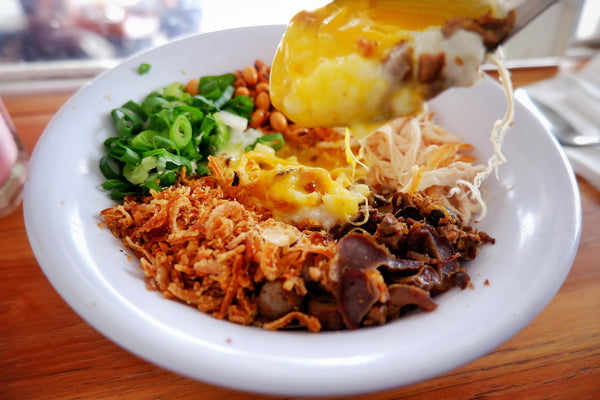
Widely available in Indonesia, Bubur (congee) is a thick, savoury rice porridge you must try. The most common Bubur you can find is the Chinese-style Bubur Ayam (chicken porridge), topped with shredded chicken, fried shallot, cakwe (fried crullers), pickled vegetables, broth, and sweet soy sauce.
A bowl of warm Bubur Ayam first thing in the morning is so deliciously appetizing. For a fulfilling breakfast, finish it off with a glass of hot coffee or teh tarik. For those preferring something sweet, there's also the bubur Madura (named after the Madura island), made of black sticky rice, sago pearls, and fresh coconut cream.
Fun fact: If you want to spark an instant debate among Indonesians, ask them this: do you prefer to eat your porridge mixed or separated? You’ll hear some interesting answers!
~
2. Nasi Goreng (Fried Rice)
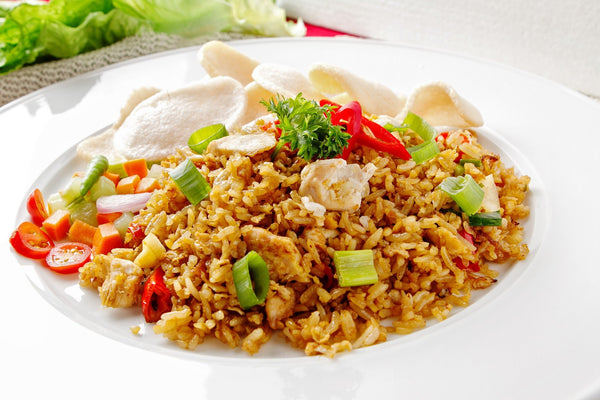
You’ve probably already heard about Indonesian's undying love for fried rice. In Indonesia, there are a lot of rice dishes because there’s a common saying there: "you haven’t yet eaten if you haven’t eaten rice".
Fried rice varies from place to place, and you can find various meat of your choice. One local favorite is the Javanese-style fried rice because it' got a kick to it from the sambal (chili paste) and the umami flavor from the garlic and grease-coated rice.
Fun fact: Like almost every Indonesian food, you can find this common dish everywhere, from street vendors to 5-star hotels. The street food version of nasi goreng is likely more authentic.
~
3. Gado Gado (Peanut Salad)
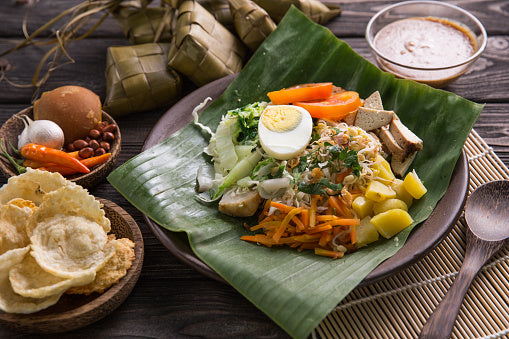
A break from rice dishes, gado-gado is Indonesian's version of salad. Yep, this one is for you vegetarian peeps. However, this salad is unlike your typical side-dish salad with a light dressing.
Gado gado means mixing, and the dish itself basically is a mixture of blanched vegetables such as bean sprouts, kangkung (water spinach), long beans, potatoes, cabbage, fried tofu, tempeh, and hard boiled eggs, all served with peanut sauce dressing.
Fun fact: Gado-gado originates from West Java. In Central and East Java, you’ll find another version called Pecel with the same peanut salad concept, but served with rice.
~
4. Lontong Sayur (vegetable soup with steamed shaped rice)
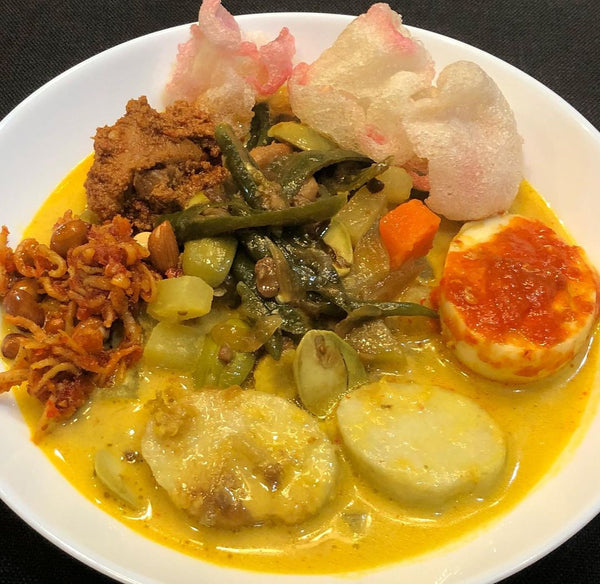
Another must try Indonesian dish is Lontong Sayur, a traditional food from Minangkabau, North Sumatra and is a staple dish in family celebrations such as Eid Mubarak.
This dish is basically lontong (rice steamed in banana leaves shaped into a tube - similar to Malaysian lemang but smaller in size) served in coconut milk soup with a delicious balance of meat and vegetables.
The soup base is made of vegetable broth and santan (coconut milk) and topped with tempeh, egg, rendang, sambal lado merah (tomato-based chili paste), and pickled vegetables.
Fun fact: Locals in Indonesia sometimes pack and compress their rice into lontong so they can carry them around safely.
5. Jajanan Basah (Traditional Snack / Kue / Kuih)
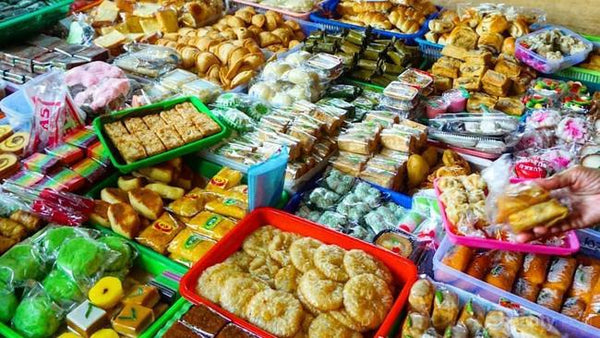
These assorted choices of snacks are often found accompanying brunch time. The local delicacies incorporate various multi-cultural influences. For example, Bakpia is of Peranakan origin, Kue Putu is derived from Indian Puttu, while the colorful lapis is European influenced. These snacks are also known as Jajanan Pasar (translated as market snacks) because they sell them in traditional markets.
Most of these snacks are either sweet or savoury and usually uses rice flour and coconut base. Drizzled with palm sugar or powdered sugar, you can eat them as breakfast or dessert! Some of the most common kue are lemper (similar to lontong and filled with meat), bika ambon (yellow sticky cake made of tapioca flour), and kue getuk (made of cassava flour and coconut sugar and served with sweetened grated coconut).
Fun fact: For aesthetic purposes, the snacks are displayed beautifully in a tampah or a bamboo winnowing pan. This can also function as hampers and gifts.
~
6. Soto (Chicken Soup)
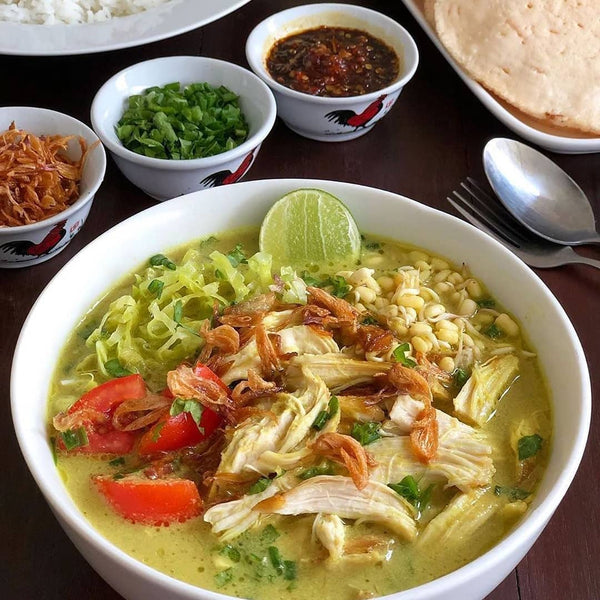
Feeling a little bit chilly? Soto is here to warm you up! This comfort food is what you call a chicken soup in the West, with warm yellow soup loaded with shredded chicken, noodles, egg, fried garlic, and sometimes served with rice or lontong.
The yellow base is made from turmeric, an Indian influence, and the fried garlic and bihun (clear thin vermicelli noodles) are influence from Chinese cuisine. In Jakarta, a variation you can find is Soto Betawi which uses minyak samin (Arabian ghee). Condiments often served with soto are sweet soy sauce, lime juice, and sambal.
Fun fact: Every region has its own versions of soto. There are at least 75 versions and 48 different spices used!
~
7. Nasi Campur (mixed rice)
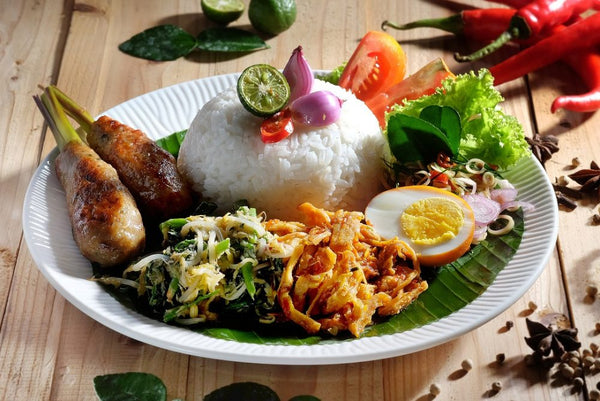
Nasi campur is the soul of Indonesian food. Why? Because there is no exact rule on how you can eat this and you can mix whatever meat and vegetables you like. Are you a fan of rendang? Add it in! Do you like Balinese roasted pork? Sure, nobody is stopping you.
Although mixed rice, you won’t find your food mixed into one like gado gado. Instead, you’ll find a small portion of meat, vegetables, egg, noodles, peanuts, sambal, and kerupuk (crackers) plated circularly around a scoop of rice.
Fun fact: The image above is Balinese nasi campur, or Nasi Bali, which has a distinct taste from the ones you’ll find in Java because they use the Balinese spice mix with curry base and lard.
~
8. Mie Goreng (fried noodle)
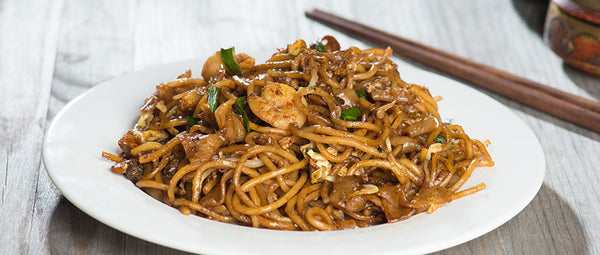
Are you a fan of Indomie? Then you've got to try the original stir fried noodle! This noodle is different from the Chinese-style chow mein. The original Mie Goreng is fried with sweet soy sauce, hence is sweeter and also has plenty of vegetables and fried shallots.
A popular version is the mie goreng Aceh, named after the coastal Aceh province, where the noodle is cooked with a spicy curry broth and served with various seafood.
Fun fact: Indomie is undoubtedly a very popular breakfast food in Indonesia because it’s fast and cheap to prepare. You may have already tried some in your country, but you’ll find the local Indomie very flavorful!
~
9. Bakso (Meatball Soup)
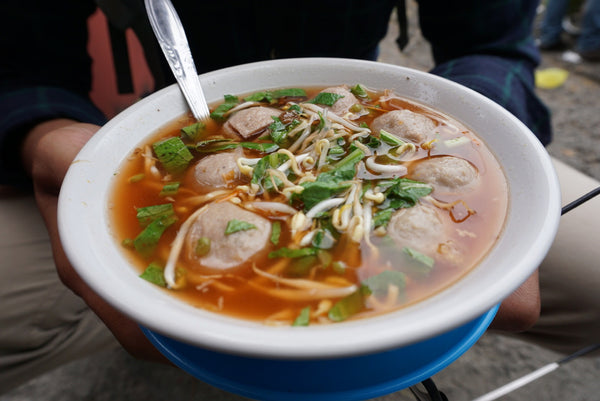
The king of street food, bakso is a fusion of the Chinese bah-so and the Dutch meatball. These balls are made from finely ground beef with salt, chicken stock, and tapioca flour for that extra firm chewiness.
A typical bowl is usually served with yellow noodle and rice vermicelli in beef broth and sometimes served with tofu and crispy fried wonton. Another type of bakso you can find is the meatball snack pentol. Pentol is a slightly smaller versions of bakso dipped in sweet soy sauce and peanut sauce.
Fun fact: There are lots of bakso vendors even on one single street. The local intelligence services often disguise themselves as bakso sellers, walking around to spy on suspicious activities. You won’t realize it though :D
~
10. Gorengan (fried snacks)
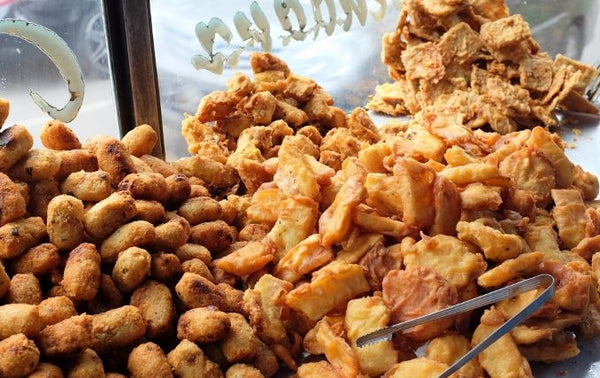
Last on this list is Indonesian fried snacks, or gorengan. There are various deep-fried snacks you can try if you are after some light bites for breakfast. The crunchier and greasier, the better! The varieties are so many you won’t be able to try all of them in one day.
The most popular varieties among them are pisang goreng (fried bananas), tahu crispy (crispy fried tofu), singkong goreng (fried cassava), bakwan goreng (fried vegetable mix), and tempe tahu goreng (fried tofu and tempeh).
Fun fact: No gorengan is complete without mini green chilis (much like bird's eye chilli). The locals can eat up to 5 chilis for one small gorengan! Even if you’re not a fan of spicy food, you should absolutely try it.
~
Did you enjoy this article? Share it below with your family & friends!